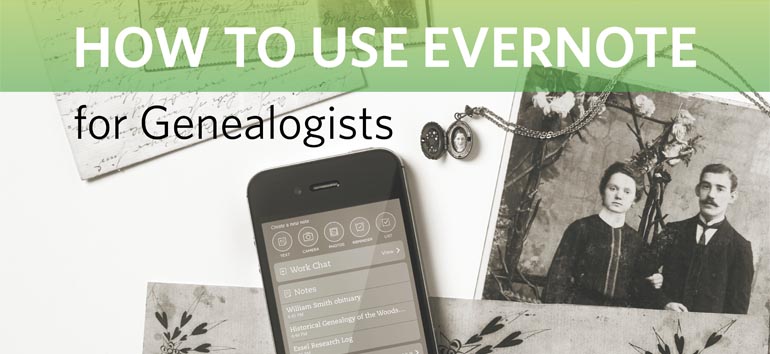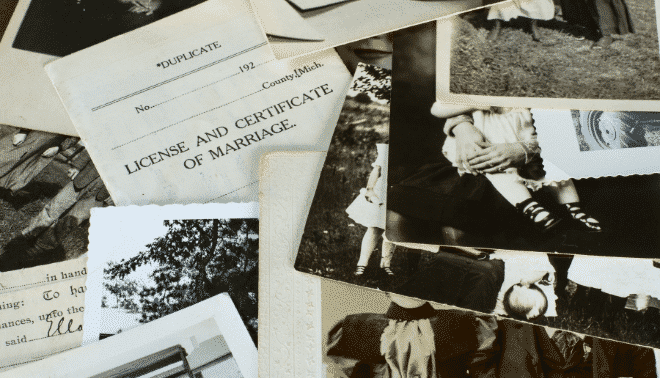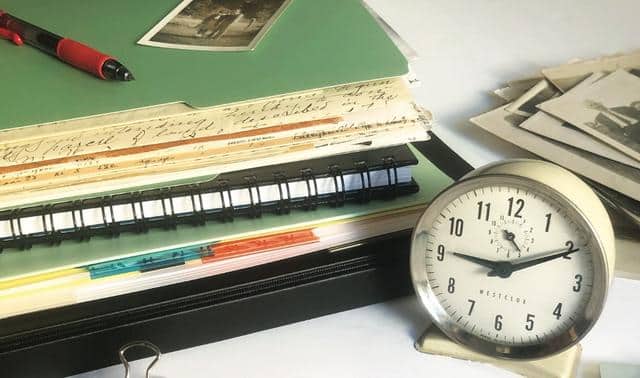Maybe this happens to you often: you get excited about ramping up your genealogy research and decide to dedicate all of your time to making exciting discoveries about your ancestors. Filled with enthusiasm, you set out to track down every record, glean every document you can get your hands on, and plot out your entire family tree. Your goals are ambitious; they may even multiply.
You may make good progress on your research for a while. Then you stumble upon an obstacle, uncover a new project or just lose interest in your current project altogether—and that research project gets cast to the side, lost under a pile of papers or a mountain of other to-do’s.
One way to prevent this cycle is reimagining the genealogy goals you set for yourself. The SMART model is one popular method, allowing you to craft specific, feasible goals that identify clear research benchmarks and keep you engaged in your work.
Read on for what genealogy SMART goals are, and how they can help your research.
What Are SMART Goals?
“Smart” is not just a descriptive adjective; it is an acronym. The letters represent essential qualities of an effective goal, which are:
S—Specific (The goal should not be too general but instead should have a clear focus.)
M—Measurable (The goal should have accompanying metrics or criteria that allow for you to accurately track progress and reach an established completion point.)
A—Achievable/Attainable (The goal should be feasible given your current circumstances.)
R—Relevant (The goal should mirror any other larger, overarching long-term goals presently in place.)
R—Realistic (The goal should complement any of your other current goals.) or (The goal should be possible to achieve with the resources and free time at your disposal.)
T—Time-Bound (The goal should have a concrete deadline.)
Questions to Ask
Here are some questions that you can ask yourself to ensure that your own goal meets the SMART goal criteria:
Specific Questions
- Can you make a detailed list of steps that you must take to complete your goal?
- Does your goal contain specific verbs, adjectives and nouns to describe what you wish to accomplish? (e.g., “more efficient” instead of “better”)
- Is the scope of your goal narrow enough so that you will be able to focus on a specific area of research (a person, generation, family or line) instead of many more general ones?
Measurable Questions
- Can you tangibly quantify your progress by counting it, measuring it or evaluating it using a rubric?
- What tools can you use to measure your progress?
- How could you monitor your progress regularly?
- Does the goal have a concrete endpoint?
Achievable/Attainable Questions
- What steps would you need to take today to ensure that you can achieve this goal?
- Have you met goals similar to this one in the past?
- What skills do you presently have that could help make this goal more manageable?
Relevant Questions
- What are some other genealogy goals you have?
- How will this goal expand your knowledge of your family history and genealogy as a whole?
- Will this goal benefit your genealogy in other ways, such as expanding your knowledge of your family history or sharpening your research skills?
Realistic Questions
- Do you have any resources presently at your disposal that could help make achieving this goal easier? What are they?
- What issues might presently hold you back from achieving this goal? Can you reasonably rectify or minimize them?
- What resources or tools would you need to acquire to make this goal feasible? Are they easily within reach?
Time-Bound Questions
- How much time do you think your goal will take to reach?
- What other priorities or obligations do you have in the near future?
- Would you be able to adjust your deadline accordingly if a situation were to arise?
Example of a SMART Goal
It can be hard to create your own SMART goals if you don’t know what one looks like. Below is example of a genealogy research goal and a breakdown of how to qualifies as a SMART goal.
Goal: By Dec. 30, I will improve my genealogy research strategy by focusing on a different topic each month, according to my genealogy research plan, which I will manage via my Trello account.
Specific
Why this is specific: With this goal, you avoid vague adjectives like “better” and weak verbs like “get.” Instead, you describe exactly what you aim to do (improve genealogy research strategy), how you plan to do it ( focusing on a different topic each month) and the tools you plan to use to accomplish the task (Trello).
Measurable
Why this is measurable: Keeping track of your tasks via a task management system like Trello not only keeps you organized, it also helps you stay accountable. As you check off tasks, you get a clear quantifiable picture of what you have accomplished—and, if any tasks remain unchecked, what you may be able to improve upon.
Achievable/Attainable
Why this is achievable/attainable: While it’s human to daydream about the glory of reaching the finished line with a completed project, it is important to consider how you can get there. You might tell yourself that you will work on your research every day, which may be doable, but you also have to take into account the demands of everyday life: your family, your health and general well-being. Setting a goal of one research topic per month allows you to zero in on specific areas of focus instead of trying to tackle everything at once. All that said, you might adjust the amount of time spent on the task depending on your needs, desires and lifestyle. What is important is that the goal is achievable to you.
Relevant
Why this is relevant: This aspect of the SMART goal requires you to think more deeply about your “why?”—that is, why are you embarking on your genealogy journey in the first place? This goal touches upon that by identifying a key motive: that you want to learn more about who you are and where you came from, and maintaining a clear research plan at which you chip away a little each month allows you to make these discoveries.
Realistic
Why this example is realistic: This goal forces even the most ambitious genealogist to condense their research scope so that they are focusing on one area per month. That way, they can focus on organizing and analyzing a few specific types of records instead of feeling pressured to uncover every minute detail about their ancestors.
Time-bound
Why this is time-bound: When you give yourself an exact deadline, you are giving yourself something to strive toward and to look forward to. The goal above establishes Dec. 30 as the big day, which allows for plenty of time to work to be done while still making known a concrete finish line.
Helpful Tools for Managing Your Goals
Sometimes, it isn’t enough mentally decide on a goal and chart your progress. You need a tool that you can track your progress and keep you accountable.
Fortunately, technology makes this easier than ever. Below are some tools that can help you through every step of your journey.
Evernote
Taking notes consistently can be tricky, especially when great ideas seem to pop into your head at the most inconvenient times. Fortunately, Evernote is a cloud-based tool that allows you to take notes anywhere and save them to review whenever you want. Whether you take notes on your laptop or smartphone, Evernote will sync your work across devices. So if you have an epiphany about great-great grandfather’s voting records in the grocery store, you can simply pull up the Evernote app on your phone, jot down what you need to, and then access it when you are ready to wade deep into your research. To start a note, you simply click the green +New button as featured below.
Evernote also makes it easy to manage tasks. For example, if you want to devote an hour in the evening to reading a collection of records, you start a new task (located in the same place where you would start a new note). Just be sure to specify how long it will take and when you want to be done with it.
Evernote offers a free 7-day trial, and is free to use within certain device and data-upload limits. For use on unlimited devices, you can subscribe for a paid plan.
Trello
Like Evernote, Trello allows you to manage your tasks from one place—and that’s what it’s entirely devoted to! You can create a board that outlines all the tasks you need to complete, then check them off as you complete them. You can also sort your tasks by category.
For example, perhaps you want to create a Trello board for your genealogy project and devote a list to each of the record types that you plan to research. You can then assign specific tasks, or cards, these lists to ensure that you stay on task. Once you are done with the task, simply check it off.
Below you can see an example of a Family Research Project Trello board and corresponding cards.
You can use Trello for free by signing up with an existing Google, Microsoft or Apple account. A free account gives you 10 boards and unlimited cards. Paid plans billed monthly or annually are also available.
Google Sheets
Spreadsheets are an excellent way to manage your research. They are especially useful if you have a lot of data you want to keep track of—for example the names, birthdates, death dates and marital status of dozens of different relatives. You can download the Google Sheets app for free.
Journals and Notebooks
Maybe you enjoy the feeling of writing down an important note in an old-fashioned notebook and carrying it with you wherever you go. That’s still a perfectly valid way to track your progress and manage your goals!
As a general tip, it might be helpful to devote certain pages to specific topics. For example, you would devote the first 30 pages of your notebook to logging your daily progress, then the following 30 personal notes related to your research. That way, you don’t have to worry about your thoughts getting jumbled. You might even use two or three separate notebooks for different tasks.
Related Reads
A version of this article was posted online in January 2023. Last updated: July 2025














